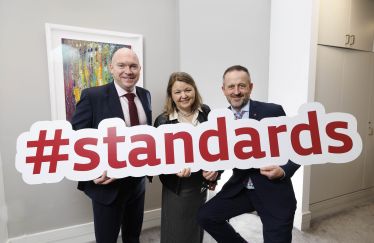As thousands of children begin their summer holidays tomorrow, the NSAI (National Standards Authority of Ireland) is urging people, particularly parents, to look for standards when buying popular summer items such as sun glasses, suncream, arm bands and tents. These standards ensure that products are safe and fit for the purpose.
- “As people are making plans for this summer to attend parties, festivals and events it is important to be aware of the standards of the products you are buying for yourself and your family, to ensure a safe and enjoyable summer. Be sure, for example, that the sunglasses you are wearing actually protect against UV rays. If you’re buying a trampoline for the kids, be sure that it meets the appropriate safety standard. These apparently small things can make a profound difference to your health and safety and your summer,” said Maurice Buckley, CEO, NSAI.
NSAI’s Top Five Summer Safety Tips
- Look for the UVA standard on your sunscreen: In 2012, a new ISO standard, ISO 24443, was established to help laboratories and the cosmetics industry to measure the UVA performance of sunscreen products and ensure people are better protected against the harmful rays of the sun. When first created, sunscreens were only designed to filter out UVB (Ultra Violet B) rays, as the dangers represented by UVA (Ultra Violet A) rays were then unknown. Today, sun protection products must span the entire UV spectrum. When buying sun cream, make sure you look out for the UVA symbol (see picture above). A four or five UVA star rating is best for fair skin.
- Protect Your Vision: When looking at the latest, most fashionable sunglasses consumers should choose options that meet the I.S. EN 1836 standard. This ensures that eyewear purchased offers protection against solar radiation or UV rays. Eyewear that does not offer protection from solar radiation or UV rays can damage your eyes.
- Check arm bands and swimming costumes for standards: Make sure children’s swimming costumes and armbands meet the relevant standards and display the CE mark. The I.S. EN 13138 standard for buoyancy aids ensures that rigorous safety test methods have been put into use and that aids are safe to be worn by your child.
- Check the CE mark on trampolines and bouncing castles: When buying a trampoline, make sure it comes with a safety net and a protective pad around the springs and that it also displays the CE marking (this ensures it meets the I.S. EN 13219 standard). Bouncing castles should meet the I.S. EN 14960 which tests and ensures that materials, design and structural integrity of the inflatable unit is fully safe and reliable for use. Ensure that the inflatable is securely anchored with a minimum of six anchorage points.
- Look for CE marks on tents: If you are one of the thousands of music lovers getting ready to go to one or more of this year’s summer festivals, look out for the CE marking and standards on tents and camping equipment before you purchase. I.S. EN 15619 and I.S. EN 13782 are both tent safety standards that will ensure the design, structure and fabric used in your tent is reliable, secure and flame retardant to avoid a dangerous situation.
What does the CE Mark mean?
The CE mark is the manufacturer’s declaration that the product complies with environmental, health and safety standards. By affixing the CE Marking to a product, the manufacturer assumes full responsibility for its compliance with all safety requirements.
Unfortunately, due to counterfeiting or the misuse of CE marking, there is never a 100% guarantee that a product bearing the mark is safe. Although most European manufacturers, importers, and distributors follow the rules, consumers can also play an important role in improving the safety of products:
Always buy products from trustworthy shops and online outlets: If an offer seems too good to be true, it may well be. Trustworthy shops take care with the products they sell and usually accept returns. On the other hand, rogue traders tend to ignore health and safety rules, and may also sell fake products. Read all warnings and instructions. Be aware of age and safety recommendations, especially in the case of toys.
Always report a safety problem: Inform the manufacturer or the retailer from whom you bought the product. In addition, contact the appropriate public authority, the market surveillance regulator, the CCPC (Competition and Consumer Protection Commission). This ensures that further steps to ensure the safety of the product will be taken. To get in touch with the CCPC, visit consumerhelp.ie
NSAI CEO Maurice Buckley said standards affect our everyday lives, but often we take them for granted:
- “You expect, for example, that the seat belt you put on when you get in the car will keep you safe because it is made to a standard. The brakes will work because they are made to a standard. The toys your children play with – made to standards. Most of the products we encounter in any day, the services we use, will all be governed by standards. But what many people don’t realize is that standards for many items are voluntary. Therefore, I would encourage people to pay particular attention to the products they buy, look out for standards logos and symbols and don’t be afraid to ask questions,” said Mr. Buckley. “And of course you can also check out the NSAI website, NSAI.ie or call our offices for information on standards,” he added.
For further information, visit NSAI.ie or follow us on Twitter @NSAI_Standards



